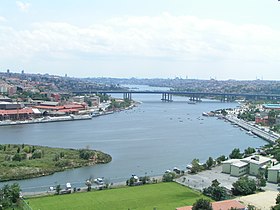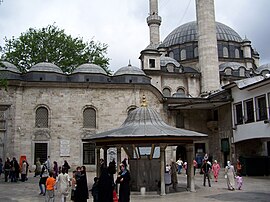Eyup
| Eyup | |||
|
|||
 View of the Golden Horn from the Pierre Loti Café |
|||
| Basic data | |||
|---|---|---|---|
| Province (il) : | Istanbul | ||
| Coordinates : | 41 ° 3 ' N , 28 ° 54' E | ||
| Residents : | 349,470 (2012) | ||
| Telephone code : |
(+90) 212 (European part) (+90) 216 (Asian part) |
||
| Postal code : | 34 xxx | ||
| License plate : | 34 | ||
| Structure and administration (status: 2014) | |||
| Mayor : | Remzi Aydın ( AKP ) | ||
| Website: | |||
| Eyüp district | |||
| Residents : | 367,824 (2014) | ||
| Surface: | 224 km² | ||
| Population density : | 1,642 inhabitants per km² | ||
| Kaymakam : | Abdullah Dölek | ||
| Website (Kaymakam): | |||
Eyüp , since 2017 Eyüpsultan ( Middle Greek up to the 10th century τὰ Παυλίνης ta Paulinēs , then Κοσμίδιον Kosmidion ), is the capital of the district of the same name in the Turkish province of İstanbul and a district on the European side of İstanbul . According to the last census, the district of Eyüp had 367,824 inhabitants (as of 2014).
history
The modern Eyüp was already settled in the Byzantine era, then known as Kosmidion. The name comes from the monastery of the Anargyri (the saints Kosmas and Damian ), which was founded in the 5th century. According to a later legend, the founder is said to have been the magister Paulinus , who was executed by Theodosius II (ruled 408-450) because he was mistaken for a lover of the Empress Aelia Eudocia . In reality, it dates from around 480 and was founded by Paulina, the mother of the general and unsuccessful usurper Leontius . The quarter that formed around the pen was named after her τα Παυλίνης ta Paoulines (Paulinas [quarter]). The monastery was a major religious center in Constantinople in the 6th century: the abbots attended the synods of 518 and 536, several miracles related to its two patrons emerged, and the abbey was reigned as part of the building program of Emperor Justinian I ( 527-565) extensively renovated. In 623 and 626 the Avars besieged and looted the building.
Since the beginning of the 10th century the settlement was called Kosmidion and was a kind of suburb of Constantinople. It is unlikely that Kosmidion and ta Paoulines were adjacent but different locations. In 924, Emperor Romanos I Lakapenos (ruled 920–944) met the Bulgarian Tsar Simeon I at a pier in Kosmidion during the Byzantine-Bulgarian War of 913–927. Theophylaktos Lakapenos , Romanos' son and Patriarch of Constantinople from 933–956 had his stables in Cosmidion.
Emperor Michael IV (ruled 1034–41) renovated the monastery complex and lived there after his abdication. He died shortly afterwards as a monk. Due to its proximity to Constantinople, the site also played a role during the civil wars of that period. It was the headquarters of the rebel Leon Tornikios (according to other sources this was Thermopolis ) during his unsuccessful siege of the imperial capital in 1047. It was also the base of John Bryennios , another usurper and brother of the insurgent general Nikephoros Bryennios the Elder , in 1077 and four years later it was one of the first places that the Komnenen in their successful coup against Nikephorus III. Botaneiates (ruled 1078–81) received. In 1096 the army of the First Crusade was allowed to camp between Kosmidion and Hagios Phokas .
As part of the Fourth Crusade , Kosmidion was the site of an early skirmish between the Latins and the Greeks in July 1203, which the Crusaders won. In April 1204, shortly before the fall of Constantinople, the Venetian doge Enrico Dandolo negotiated here with the new emperor Alexios V. Dukas Murtzuphlos .
Under the Frankish rule , the monastery seems to have been largely left alone; because Emperor Michael VIII Palaiologos (ruled 1259–82) stayed there on the night of August 14, 1261, before his triumphal entry into the recaptured city the next day. For the next few decades the monastery became a retreat for two exiled patriarchs, Joseph I from 1280–82 and John XI. Bekkos in 1285, while he was waiting for the judgment of the synod, and finally Athanasios I for the time immediately before his abdication in 1293. From 1261 further miracles were reported, a compilation was made around 1300 by a certain deacon Maximos.
In 1303 Catalan mercenaries in the service of the empire under the leadership of Roger de Flor took over and fortified the monastery as a base of operations against the Genoese colony of Galata . After the emperor's break with the Catalan Company and Roger's death in April 1305, the Byzantines evacuated the area. In 1348, in a revolt against the Byzantines, the Genoese destroyed all the ships in the Golden Horn, except for the three that were built in the Kosmidion shipyard. Around 1350, the Russian pilgrim Stepan of Novgorod visited the abbey. At that time, the existence of a church consecrated to St. Theodore and a chapel dedicated to the martyrs Thalelaios and Artemidoros is documented without further information being known.
In 1410, during the Ottoman interregnum , a battle broke out in Kosmidion between two of three pretenders to the throne, Musa and Suleyman Çelebi , from which the latter emerged victorious.
After the Ottoman conquest of Constantinople , the quarter was named after Abu Ayyub al-Ansari ( Eyüp in Turkish ), a companion ( Ansar ) and standard bearer of Muhammad , who died outside the walls during the first Arab siege of Constantinople from 674 to 678 . In 1581, Sultan Murad III. a ban on Christians from living in Eyup.
Culture and sights
From Eyüp the motorway leads over the Haliç Bridge over the Golden Horn to the north of the district. Pierre Loti , a Turkophile French writer, lived in Eyüp for a few years towards the end of the 19th century and visited the café that is now named after him on the hill above the Eyüp cemetery. The square can also be reached by cable car and offers a view of Istanbul's districts on the Golden Horn.
The area has been used for burials for a long time, mainly due to its proximity to Constantinople / Istanbul. There are both Christian and Muslim necropolises there, the most famous being the Eyup cemetery.
The tomb of Abu Ayyub al-Ansari, which according to legend was found again through miraculous dreams shortly after the Ottoman conquest, is now in the Eyup Sultan Mosque and is visited by numerous pilgrims. The traditional sword girdling of the new sultans also took place here.
In May 2013 Turkey's first theme park and amusement park opened in the Istanbul district of Eyüp, the Vialand Theme Park .
Web links
literature
- Andreas Külzer : Eastern Thrace (Eurōpē) (= Tabula Imperii Byzantini . Volume 12). Verlag der Österreichische Akademie der Wissenschaften, Vienna 2008, ISBN 978-3-7001-3945-4 , therein pp. 471–473 (entry “Kosmidion”) and pp. 570 f. (Entry "Ta Paulinēs").
Individual evidence
- ^ Turkish Institute for Statistics, 2012 ( Memento from February 20, 2013 on WebCite ), accessed on May 2, 2015
- ^ Turkish Institute for Statistics, 2014 ( memento February 10, 2015 on WebCite ), accessed on May 2, 2015
- ↑ a b c d e f g h i j k l m n Andreas Külzer : Ostthrakien (Eurōpē) (= Tabula Imperii Byzantini . Volume 12). Publishing house of the Austrian Academy of Sciences, Vienna 2008, ISBN 978-3-7001-3945-4 , pp. 471–473.



